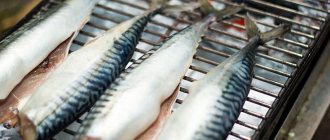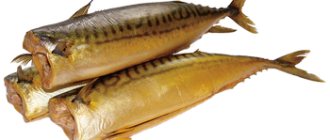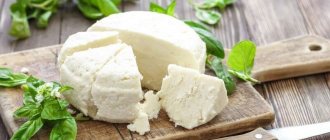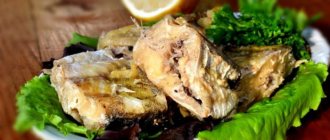Mackerel is a member of the mackerel family. This is a heat-loving, schooling fish that can reach a length of up to 60 centimeters. Mackerel has an elongated body, which is covered with small scales.
As a rule, mackerel gather in schools, and there are no fish of other species in schools. The optimal temperature for fish is from 8 to 20 degrees. During winter, the fish goes to a depth of up to 250 meters, where it leads a sedentary lifestyle, and in the spring it moves closer to the shores. The average lifespan of mackerel reaches 15-18 years.
Delicious mackerel dishes are often found on Russian tables. Both adults and children love her. But what is the nutritional value of mackerel and how high-calorie this fish is, you can find out from this article. And also below will be presented several delicious recipes for preparing this fish.
Chemical composition
The chemical composition of mackerel contains a huge amount of substances vital for the human body. The benefits of this fish are ensured by the fact that it contains the following elements:
- vitamins of group B, A, C;
- selenium;
- calcium;
- sodium;
- magnesium;
- fluorine;
- nickel;
- iodine;
- molybdenum;
- cobalt;
- phosphorus;
- iron;
- potassium;
- zinc;
- copper;
- manganese.
It is important to note that by consuming just 100 grams of this fish during the day, you can ensure that your body is full:
- selenium – 93.8% of the daily value;
- phosphorus – by 39.7% of the daily norm;
- vitamin B12 – 791.7% of the daily requirement.
The nutritional value of 100 grams of mackerel is:
- 18 grams of protein;
- 13.2 grams fat;
- 0 grams of carbohydrates;
- 0 grams of dietary fiber;
- 67.5 grams of water.
Nutritional value of mackerel
The calorie content of fresh mackerel of different types reaches 200 kcal, which is quite a high figure. However, fish is rich in microelements, vitamins, and most importantly, unsaturated fatty acids. About 100 g of product can satisfy half the daily protein requirement. Thanks to the high phosphorus content, the condition of teeth and nails significantly improves.
The share of fat is about 17%, protein – no more than 18%.
The product is recommended for people with different forms of diabetes. The benefits of frequent consumption of this fish are reduced due to the rather high fat content. This figure varies depending on what season it was caught. The spring catch is considered the most nutritious, while in the fall the fat content reaches more than 30% of the total weight of the fish.
Benefits of mackerel
This fish is enriched with Omega-3 acid, which can improve immunity and improve metabolism. Therefore, mackerel should be a mandatory product in the diet of children, people suffering from cardiovascular diseases, pregnant and lactating girls.
The protein contained in mackerel is absorbed three times faster than, for example, beef. It is also important that just 100 grams of mackerel contains half of the daily requirement for the average person.
When consuming mackerel, the level of oxygen in the cells increases, due to which all internal organs are enriched with it, and the fish also helps to launch regeneration processes in the mucous membranes and skin.
Fish oil allows you to dilate the blood vessels of the heart muscle, thereby reducing the risk of blood clots. With regular use, bones and teeth are strengthened and immunity is increased.
All the substances found in fish help ensure the normal functioning of cells, overcome harmful bacteria and establish the water-salt balance in the body. It is important that this fish does not need to be consumed in large quantities; you just need to introduce several servings of stewed or boiled mackerel into your weekly diet, and the benefits for the body will be noticeable after a few weeks.
Boiled tuna calories. tuna
Description
Tuna is a marine predatory fish of the mackerel family. Found in subtropical and temperate waters of the Pacific, Indian and Atlantic oceans. At certain periods of its life cycle it is found in the Mediterranean, Black and Japanese Seas. Refers to commercial species. The body is elongated, fusiform, narrowed towards the tail. The size varies from 50 cm to 3-4 meters, weight - from 2 to 600 kg. It feeds on sardines, mollusks and crustaceans. He spends his entire life in motion, capable of reaching speeds of up to 75 km per hour. Therefore, tuna has very developed muscles, which makes its taste different from fish. Its meat contains a lot of myoglobin, which is why it is rich in iron and has a pronounced red color when cut. Due to this, it is called “chicken of the sea” and “veal of the sea.” Highly valued for its nutritional value.
Secrets and methods of preparation
Tuna has been used as food since ancient times to this day. Widely used in both European and Asian cuisines. It is eaten raw as carpaccio, a delicious appetizer of thinly sliced meat drizzled with olive oil and lemon juice. Tuna steaks are very popular; they are fried in a frying pan or on the grill. The main secret of frying is not to overdry, so frying lasts no more than 2-3 minutes on each side, until a golden crust forms. The inside of the piece should be soft pink. The ideal thickness of such a steak is 3 cm; it allows you to fry the fish well and at the same time not dry it out. Often, before frying, the pieces are slightly marinated or breaded in egg whites and spices, this makes the fish juicier. Boiled fish is used to make sandwiches, salads and various snacks. Before cooking the fillet, you need to boil the onion, bay leaf and peppercorns in salted water. Cooking time is 10-12 minutes, after which the fish can be used as part of other dishes. Another cooking method is marinating. Marinated tuna becomes juicy and flavorful. For the marinade, citrus juice, honey and soy sauce, olive and sesame oil are used; spices can be used of your own choice. Tuna baked in the oven and stewed with vegetables turns out to be very tasty. As a side dish, it goes with almost everything - rice and pasta, mushrooms, potatoes and vegetables. You can also choose any sauces - cheese, garlic, cream, tomato and even fruit. Canned tuna, both factory-made and home-made, is very popular in the world.
Beneficial and harmful properties Benefits The benefits of tuna have been proven by repeated studies:
- is a dietary product and is recommended for inclusion in the menu for weight loss;
- has a beneficial effect on the nervous, cardiovascular, skeletal and reproductive systems;
- has a positive effect on brain function;
- prevents aging;
- improves the appearance and condition of hair and skin;
- serves for the prevention of cancer;
- stabilizes high blood pressure;
- strengthens the immune system;
- normalizes metabolism;
- excellent at breaking down cholesterol.
Harm For all its obvious benefits, tuna also has harmful properties:
- the meat of large individuals accumulates mercury and histamine in large quantities, so it is better to eat small fish;
- not recommended for use by people suffering from renal failure;
- not recommended for pregnant and lactating women;
- not recommended for children under 3 years of age.
Composition and calorie content Contains a minimum of fat and does not contain cholesterol at all. High protein content. It is a source of vitamins A, D, C and B vitamins, omega-3 unsaturated fatty acids, selenium, iodine, potassium and sodium. Calorie content - 100 kcal per 100 g of product.
Calorie content of fish
During the cooking process, the calorie content of the product depends on the type of heat treatment. The table below will show in detail what the calorie content of mackerel will be per 100 grams in boiled, fried, stewed and other types of preparation.
| Cooking method | Calorie content per 100 g (kcal) | Proteins (g) | Fat (g) | Carbohydrates (g) |
| Baked mackerel (no oil) | 181,0 | 18,7 | 11,9 | 0 |
| Baked mackerel in foil with tomatoes (no oil) | 167,0 | 17,0 | 10,8 | 0,4 |
| Fried mackerel (in oil) | 278,0 | 13,1 | 25,1 | 0 |
| Stewed mackerel in sour cream with onions and carrots | 139,0 | 11,2 | 10,0 | 1,2 |
| Cold smoked mackerel | 151,0 | 23,2 | 6,5 | 0 |
| Hot smoked mackerel | 248,6 | 21,0 | 17,8 | 1,5 |
| Boiled mackerel | 194,5 | 18,8 | 13,4 | 0 |
| Lightly salted mackerel | 196,4 | 21,2 | 13,3 | 0,1 |
| Dried mackerel | 152,8 | 25,2 | 4,5 | 0,9 |
| Grilled mackerel | 178,7 | 19,1 | 11,9 | 0,1 |
| Marinated mackerel | 135,3 | 11,9 | 8,5 | 3,5 |
Once you know the calorie content of mackerel per 100 grams, you can easily understand in what form this fish is most nutritious. From the presented data it is clear that hot smoked mackerel will have the most calories. But from eating this fish in stewed or pickled form, the body will receive fewer calories.
Having understood what nutritional value mackerel provides the body and what health benefits it can bring, you can begin to consider the simplest and most delicious recipes.
Smoked mackerel calories. From the store shelf to the table
The calorie content of lightly salted mackerel will interest us first of all, because such fish does not need to be cooked. It is enough to boil the vegetables for a side dish and chop it, seasoning it with herbs. And voila - dinner is ready. Very convenient for those who are always busy and cannot spend much time at the stove.
But dinner “obliges” you to know how many calories are in lightly salted mackerel. After all, it is the evening meal that “deposits extra centimeters and kilograms” in the most inappropriate places in our body.
To figure out how many calories are in salted mackerel, you need to take into account some more factors. Since salt and water have no calorie content, with standard salting the calorie content of lightly salted mackerel will be 150-160 kcal. When sugar is added to the brine, this figure will increase to 170-180 kcal, and when vegetable oil is also added, the energy value of the dish will be 190-220 kcal.
This is one of the easiest ways to serve fish to the table. I boiled the potatoes, chopped the salad and mackerel - and voila, dinner is ready. But instead of salted fish, you can take equally tasty fish. Just first, let's find out how many calories are in smoked mackerel.
The calorie content of smoked mackerel will also differ depending on the smoking method. And the processing is carried out using hot and cold methods. Therefore, how many calories are in cold smoked mackerel can be calculated very simply, because only the marinade plays a role, there is no heat treatment as such. The calorie content of cold smoked mackerel is 180 kcal.
Now you need to calculate how many calories are in hot smoked mackerel. After all, hot smoke is already a heat treatment that produces its own effects. The calorie content of hot smoked mackerel is 270-300 kcal.
Fried mackerel in vegetable oil: a simple recipe
First you need to prepare the fish. Fresh mackerel should be cleaned and washed in water.
Next, the fish is cut into equal pieces and breaded in flour with the addition of a small amount of salt. Pour a little vegetable oil into a heated frying pan (you can use either sunflower or olive oil). Next, the fish is placed in a frying pan and fried on both sides. You can serve fried mackerel with any favorite side dish.
Calories in boiled, smoked, baked fish
The method of preparing the product largely determines the calorie content. Fried mackerel is not recommended for people following a healthy diet (220-260 kcal per 100 grams). In addition, it is harmful to eat hot and cold smoked mackerel with a calorie content of 220 to 300 kcal. All these cooking methods significantly increase the fat content of the product.
It is healthy to eat boiled, baked and steamed mackerel (221, 195 and 191 kcal, respectively).
If the fish was salted at home without adding harmful ingredients, sugar and oil, as is done in mass production, then the energy value compared to the fresh product will practically not change - from 150 to 190 kcal.
Stewed mackerel in sour cream: recipe
Using this recipe for stewed mackerel, quickly and deliciously cooked in the oven, you can feed your household. At the same time, this dish will not only help saturate the body and satisfy hunger, but will also bring benefits.
First you need to prepare the ingredients, namely:
- mackerel - 1 pc.;
- potatoes – 500 g;
- carrots – 100 g;
- onions – 2 pcs.;
- tomatoes – 2 pcs.;
- sour cream (15% fat) – 100 g;
- herbs, salt, vegetable oil, spices - to taste.
The mackerel is cleaned and cut into small pieces. Vegetables should also be peeled, washed thoroughly under water and cut. Next, you need to lay out the ingredients in layers in a fireproof form, greased with vegetable oil:
- 1st layer - potatoes;
- 2nd layer – fish;
- 3rd layer – onions and carrots;
- 4th layer – tomatoes;
- 5th layer – greens.
Each layer needs a little salt. Then add sour cream to the pan and place it in the oven for 30 minutes. Cooking mackerel in the oven is quick and tasty. The dish can be served without additional side dish.
How many calories are in mackerel
The calorie content of mackerel depends on the time of year and where the fish are caught. The colder the water, the more fat the mackerel contains, the more calories there are in the mackerel. The fattest, most delicious mackerel is caught in the northern latitudes, in winter. It is winter fish caught in the northern seas that will have the maximum fat content - about 30%. Fish caught in more southern latitudes in the spring-autumn period has less fat. But this figure does not fall below 13%.
The calorie content of mackerel, depending on the season and place of catch, can vary significantly
. It is generally accepted that the calorie content of mackerel ranges from 150 to 200 kcal. Of course, such a significant discrepancy creates some difficulties for those who strictly consider the number of calories in food. In this case, you can use the average and assume that the calorie content of mackerel is 175 kcal.
Cooking mackerel in a slow cooker: recipe
Having a multicooker makes preparing any dish much easier. In the case of this fish, you should first pour a little water into the bottom of the bowl. Next, you need to clean the fish, cut it and salt it. Cover a special container for steaming with food foil and place the mackerel in it. Next, put a little onion, cut into half rings, and a few slices of lemon on top of the fish.
Cook the fish in the “Steam” mode for 25-30 minutes. This fish will be useful for both children and adults.
Contraindications for eating mackerel
It is important to understand that any product is useful if you follow moderation when consuming it. Since the calorie content of mackerel is significant, it should not be abused if you are overweight
. Although you shouldn’t completely give up this healthy fish.
Mackerel, being a very fatty fish, should be used with caution by those who have impaired liver and pancreas function. In case of these diseases, smoked and salted mackerel should be completely excluded from the diet. People with kidney disease should do the same.
Definitely, those who are allergic to fish and seafood should avoid mackerel.
Popular articles
Mackerel is a fish that belongs to the category of those that can often be found on any table. It is affordable, and, most importantly, tasty and healthy, which is why most of us choose it. Mackerel or mackerel, as it is also called, belongs to the mackerel family of the order Perciformes. The fish lives mainly in the Atlantic Ocean, Black and Mediterranean Seas. It is a predator and feeds mainly on small fish, which largely affects its taste characteristics. The calorie content of mackerel can be called quite high compared to other types of fish. But the fattier this fish, the more tasty it is. It’s not surprising that in the store we choose fatter mackerel. There are many recipes for cooking mackerel. It turns out delicious in any form, so if you are not afraid of the calorie content of mackerel, then you do not have to limit yourself in choosing the method of preparing this fish.
Harm to mackerel
For a healthy body, this fish cannot cause any harm. However, it should be remembered that if you have diseases such as kidney failure, hypertension, pancreatitis or cholecystitis, mackerel should not be consumed salted or smoked.
If you have problems with the gastrointestinal tract, you need to exclude this fish from your diet. In some cases, it is permissible to consume mackerel only in boiled form. However, it is worth remembering that high fat content can lead to unpleasant consequences. Therefore, you should discuss with your doctor the inclusion of this product in your diet.
Calorie content of mackerel after cooking
The above figures were related to the calorie content of fresh mackerel (fillets). But during the cooking process, the energy value of fish can change significantly.
Smoked mackerel is very popular. Mackerel prepared in this way contains a significant amount of calories: about 220-225 kcal. Proteins will be 20-21%, fats – 15-16%.
Mackerel is also popular in salted form. Its energy value in this case is maximum. How many calories are in salted mackerel?
As much as 300, and sometimes all 315 kcal. But all the beneficial substances of mackerel are almost completely preserved, of which this delicious fish contains a lot.
Smoked and salted mackerel cannot be classified as a dietary dish. Firstly, due to the high calorie content of mackerel prepared using these methods, and secondly, due to the high salt content in fish, which, as is known, is unacceptable in dietary nutrition.
Boiled or steamed fish is suitable for dietary nutrition. From the point of view of preserving nutrients, it is worth giving preference to steamed dishes. The calorie content of steamed mackerel is about 170 kcal. There are even fewer calories in boiled mackerel - no more than 130 kcal. But there are also fewer valuable substances, since a significant part of them went into the decoction (broth).
Many people love fried mackerel. The calorie content of fried mackerel is about 180-190 kcal. Mackerel baked in the oven is healthier and has slightly lower calorie content. The energy value of the fish in this case will be no more than 175 kcal.
A dish is considered low-calorie if its energy value does not exceed 100 kcal per 100 g of finished product. Mackerel does not fit into this framework. However, this fish can and should be used in diet for weight control. Especially if not only diet, but also physical activity is used to achieve slimness. After all, with a significant calorie content, mackerel supplies the body with easily digestible protein
, which is used to build muscle tissue, and valuable fats necessary to strengthen intercellular membranes and vascular walls. Also, mackerel contains many substances that activate metabolism.
Boiled and steamed mackerel, cutlets and soufflé made from it can be included in the menu of patients suffering from stomach and duodenal ulcers. The fairly high calorie content of mackerel will be a great advantage during the recovery period after illnesses and injuries. This fish can and should be included in the diet of athletes.
Fresh
Of all the consumed varieties of fish products, mackerel is one of the most popular and versatile.
As a food product, it is equally actively used both in raw (mainly frozen) and in ready-to-eat form - salted, pickled, smoked or canned. Proper cooking methods include boiling, preferably steaming, and grilling or baking without using fat. With this heat treatment, mackerel meat is easily digestible, and the biologically active substances it contains have a number of beneficial effects on the human body:
- normalize digestive processes;
- improve the functioning of the heart muscle, strengthen the heart, help prevent heart attacks;
- cleanses blood vessels, strengthens their walls;
- increase brain activity;
- maintain visual and hearing acuity;
- remove toxins, waste, harmful salts, decay products;
- actively contribute to the normalization of metabolism;
- provide quick and long-lasting saturation;
- increase activity, give vigor and stimulate performance;
- reduce the severity of symptoms in case of problems with joints, especially in cases of impaired mobility (due to the activation of the formation of cartilage tissue);
- saturate the body with vitamins, macro- and microelements, and other beneficial substances.
https://www.youtube.com/watch?v=https:accounts.google.comServiceLogin
Mackerel meat is recommended for consumption by women at any stage of pregnancy and during breastfeeding, as well as by adolescents during puberty. Also, the meat of this fish, saturated with many useful substances, high-quality protein and valuable fat, is ideal for therapeutic and restorative nutrition, since it is easily digestible and perfectly saturates, without overloading the body with excessive work.
It is not recommended to introduce any fish dishes and products into the diet, including mackerel, only if you have an allergic reaction or individual intolerance. All other restrictions and contraindications can only be associated with the correct choice of cooking option and serving size: everyone, without exception, can eat a moderate amount of mackerel, boiled or grilled.
The harm of mackerel meat can only be caused by purchasing a low-quality or stale product. In addition, during its life, marine fish accumulate heavy metals (primarily mercury), so it is recommended to choose small fish that have not had time to grow and increase the amount of such dangerous “accumulations”. The optimal length is 30 cm and weight is 0.5 kg.
Calorie content of mackerel cooked in different ways
As already mentioned, mackerel is delicious in any form. The calorie content of mackerel is about 200 kcal per 100 g. One of the most preferred methods of preparing this fish is salting. Salted mackerel is perfect for a festive table, but it will also be appropriate on a regular menu. The calorie content of salted mackerel makes it a filling dish, so even a sandwich with a piece of salted mackerel will quickly fill you up and keep you feeling full for a long time. The calorie content of salted mackerel is 260 kcal. To prepare such fish, a significant amount of salt is used, which significantly increases the calorie content of salted mackerel.
Smoked mackerel is especially tasty. This is largely due to the fat content of the fish, because as a result of smoking it is not dry, but tender and soft. However, it is worth remembering that not everyone can eat smoked fish. It is contraindicated for people suffering from gastrointestinal diseases and the point is not at all in the calorie content of smoked mackerel, but in those substances that penetrate the fish during the smoking process. Thus, the consumption of smoked mackerel should be limited if you have stomach problems. As for the calorie content of smoked mackerel, it is 221 kcal per 100 g. This is a fairly high figure, so nutritionists do not recommend including smoked mackerel in their diet for people trying to lose weight. As you can see, the calorie content of smoked mackerel is slightly lower than the calorie content of salted mackerel. However, for those who are considering how many calories are in mackerel, baked mackerel is the best choice.
Baked mackerel is very easy to prepare. The choice of ingredients may vary according to the taste preferences of the cook. For example, you can bake fish with mayonnaise, but you need to understand that the calorie content of baked mackerel will increase significantly. If you use less high-calorie ingredients for this, then the calorie content of baked mackerel will be relatively low.
For example, you can cook mackerel with garlic and lemon. For this recipe, first prepare the dressing: put the garlic through a garlic press and mix with ground black pepper. Salt, juice of half a lemon and vegetable oil are also added there. Mix everything thoroughly, and then rub the resulting mixture onto the pre-cleaned fish, both outside and inside. Then a couple of pieces of lemon and chopped herbs are placed in the belly of the fish. The fish is placed in the oven and baked for 30 minutes. The calorie content of baked mackerel prepared according to this recipe will be 180 kcal per 100 g. This is a completely dietary dish that even ardent adherents of a low-calorie diet can sometimes afford.
Thus, mackerel is a very useful product that can provide the body with many useful substances and vitamins.
It is advisable to consume it, first of all, because such an amount of omega-3 acids is not so often found in other types of fish. This is all the more important because mackerel is quite affordable, unlike, say, such expensive fish as salmon or trout. The calorie content of mackerel may scare away those who are watching their figure, but if you follow the measure, then it will bring nothing but benefits to the body. 4.71 out of 5 (7 Votes)
How to cook mackerel?
Chefs love mackerel because it can be used in a wide variety of dishes.
Read: Carp - calories, nutrients, dietary recipes
In cooking, this type of fish is prepared as follows:
- fry;
- stuffed;
- salt;
- smoke;
- boil;
- steamed;
- pickled.
A small number of bones in a fish carcass makes it possible to make various rolls from it and use it in minced meat. Mackerel is a fairly fatty product, so when preparing it you should use a minimal amount of oil.
Mackerel baked in foil
Cooking technology:
- Take mackerel weighing 400-500 g, clean and wash.
- Sprinkle the outside of the fish with salt and pepper.
- Prepare the filling. Grind fresh dill, parsley, salt.
- Stuff the carcass with the filling.
- Place in foil and wrap. Place in a heatproof dish.
- Preheat the oven to 180-190°C.
- Bake for about half an hour.
The dish is recommended to be served with boiled potatoes. Can be eaten hot or cold.
Lightly salted mackerel
Cooking technology:
- Clean and thoroughly gut 1-2 mackerel, be sure to remove the gills.
- Prepare the brine. To do this, pour 2 liters of water into a saucepan, add 8 tablespoons of salt, 2 tablespoons of sugar. Put a couple of bay leaves, 10 peppercorns, 1-2 cloves. Bring the composition to a boil. Allow to cool to room temperature.
- Place the fish in the brine. Place in a cool place.
- The product is ready for use after 12 hours.
Traditionally, the dish is served with boiled potatoes.
Salted mackerel sandwiches
Cooking technology:
- Clean the salted mackerel, remove the bones and skin.
- Pour the juice of one lemon over the resulting fillet. Let stand for 15 minutes. Make small pieces if necessary.
- Slice bread, it is best to use a loaf.
- Spread the butter in a thin layer.
- Place fish pieces on the bread and place thin slices of lemon on top.
- You can decorate with a sprig of dill and parsley.
This dish will decorate any table.
Mackerel goes best with seasonings:
- lemon juice;
- garlic;
- pepper;
- Bay leaf;
- coriander.
When preparing mackerel, you should choose only high quality product. It is impossible to cook stale fish well, and there will be no benefit from it.
Grilled mackerel calories
Grilled mackerel
rich in vitamins and minerals such as:
vitamin B2 - 18.7%, choline - 12.2%, vitamin B5 - 15.5%, vitamin B6 - 34%, vitamin B12 - 360.8%, vitamin D - 140.5%, vitamin PP - 51, 6%, potassium - 14%, magnesium - 15.9%, phosphorus - 38.4%, iodine - 12.9%, cobalt - 178.4%, manganese - 16.9%, copper - 20.3%, selenium - 56%, fluorine - 31.2%, chromium - 98.1%
- Vitamin B2
is involved in redox reactions, helps to increase the color sensitivity of the visual analyzer and dark adaptation. Insufficient intake of vitamin B2 is accompanied by impaired condition of the skin, mucous membranes, and impaired light and twilight vision. - Choline
is part of lecithin, plays a role in the synthesis and metabolism of phospholipids in the liver, is a source of free methyl groups, and acts as a lipotropic factor. - Vitamin B5
is involved in protein, fat, carbohydrate metabolism, cholesterol metabolism, the synthesis of a number of hormones, hemoglobin, promotes the absorption of amino acids and sugars in the intestines, and supports the function of the adrenal cortex. A lack of pantothenic acid can lead to damage to the skin and mucous membranes. - Vitamin B6
is involved in maintaining the immune response, processes of inhibition and excitation in the central nervous system, in the transformation of amino acids, the metabolism of tryptophan, lipids and nucleic acids, promotes the normal formation of red blood cells, and maintaining normal levels of homocysteine in the blood. Insufficient intake of vitamin B6 is accompanied by decreased appetite, impaired skin condition, and the development of homocysteinemia and anemia. - Vitamin B12
plays an important role in the metabolism and transformation of amino acids. Folate and vitamin B12 are interconnected vitamins that are involved in hematopoiesis. A lack of vitamin B12 leads to the development of partial or secondary folate deficiency, as well as anemia, leukopenia, and thrombocytopenia. - Vitamin D
maintains calcium and phosphorus homeostasis and carries out the processes of bone tissue mineralization. A lack of vitamin D leads to impaired metabolism of calcium and phosphorus in the bones, increased demineralization of bone tissue, which leads to an increased risk of developing osteoporosis. - Vitamin PP
is involved in redox reactions of energy metabolism. Insufficient vitamin intake is accompanied by disruption of the normal condition of the skin, gastrointestinal tract and nervous system. - Potassium
is the main intracellular ion that takes part in the regulation of water, acid and electrolyte balance, and is involved in the processes of conducting nerve impulses and regulating blood pressure. - Magnesium
is involved in energy metabolism, the synthesis of proteins, nucleic acids, has a stabilizing effect on membranes, and is necessary to maintain the homeostasis of calcium, potassium and sodium. A lack of magnesium leads to hypomagnesemia, an increased risk of developing hypertension and heart disease. - Phosphorus
takes part in many physiological processes, including energy metabolism, regulates acid-base balance, is part of phospholipids, nucleotides and nucleic acids, and is necessary for the mineralization of bones and teeth. Deficiency leads to anorexia, anemia, and rickets. - Iodine
is involved in the functioning of the thyroid gland, ensuring the formation of hormones (thyroxine and triiodothyronine). Necessary for the growth and differentiation of cells of all tissues of the human body, mitochondrial respiration, regulation of transmembrane transport of sodium and hormones. Insufficient intake leads to endemic goiter with hypothyroidism and slowing of metabolism, arterial hypotension, stunted growth and mental development in children. - Cobalt
is part of vitamin B12. Activates enzymes of fatty acid metabolism and folic acid metabolism. - Manganese
is involved in the formation of bone and connective tissue, and is part of enzymes involved in the metabolism of amino acids, carbohydrates, and catecholamines; necessary for the synthesis of cholesterol and nucleotides. Insufficient consumption is accompanied by slower growth, disturbances in the reproductive system, increased fragility of bone tissue, and disturbances in carbohydrate and lipid metabolism. - Copper
is part of enzymes that have redox activity and are involved in the metabolism of iron, stimulates the absorption of proteins and carbohydrates. Participates in the processes of providing oxygen to the tissues of the human body. Deficiency is manifested by disturbances in the formation of the cardiovascular system and skeleton, and the development of connective tissue dysplasia. - Selenium
is an essential element of the antioxidant defense system of the human body, has an immunomodulatory effect, and is involved in the regulation of the action of thyroid hormones. Deficiency leads to Kashin-Beck disease (osteoarthritis with multiple deformities of the joints, spine and limbs), Keshan disease (endemic myocardiopathy), and hereditary thrombasthenia. - Fluoride
initiates bone mineralization. Insufficient consumption leads to caries, premature wear of tooth enamel. - Chromium
is involved in the regulation of blood glucose levels, enhancing the effect of insulin. Deficiency leads to decreased glucose tolerance.











